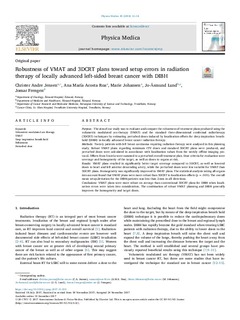| dc.contributor.author | Jensen, Christer André | |
| dc.contributor.author | Roa, Ana María Acosta | |
| dc.contributor.author | Johansen, Marie | |
| dc.contributor.author | Lund, Jo-Åsmund | |
| dc.contributor.author | Frengen, Jomar | |
| dc.date.accessioned | 2019-01-29T13:07:31Z | |
| dc.date.available | 2019-01-29T13:07:31Z | |
| dc.date.created | 2018-06-30T12:27:53Z | |
| dc.date.issued | 2018 | |
| dc.identifier.citation | Physica medica (Testo stampato). 2018, 45 12-18. | nb_NO |
| dc.identifier.issn | 1120-1797 | |
| dc.identifier.uri | http://hdl.handle.net/11250/2582843 | |
| dc.description.abstract | Purpose
The aim of our study was to evaluate and compare the robustness of treatment plans produced using the volumetric modulated arc-therapy (VMAT) and the standard three-dimensional conformal radiotherapy (3DCRT) techniques by estimating perturbed doses induced by localization offsets for deep inspiration breath-hold (DIBH) in locally advanced breast cancer radiation therapy.
Methods
Twenty patients with left breast carcinoma requiring radiation therapy were analysed in this planning study. Robust VMAT plans regarding minimum CTV doses and standard 3DCRT plans were produced, and perturbed doses were calculated in accordance with localization values from the weekly offline imaging protocol. Offsets from 5 weeks were summed to a perturbed overall treatment plan. Dose criteria for evaluation were coverage and homogeneity of the target, as well as doses to organs at risk.
Results
VMAT plans resulted in significantly better target coverage compared to 3DCRT, as well as lowered doses to heart and left anterior descending artery, while the perturbed doses were less variable for VMAT than 3DCRT plans. Homogeneity was significantly improved in VMAT plans. The statistical analysis taking all organs into account found that VMAT plans were more robust than 3DCRT to localization offsets (p = .001). The overall mean setup-deviation for the DIBH-patients was less than 2 mm in all directions.
Conclusions
VMAT plans were more robust on average than conventional 3DCRT plans for DIBH when localization errors were taken into consideration. The combination of robust VMAT planning and DIBH generally improves the homogeneity and target doses. | nb_NO |
| dc.language.iso | eng | nb_NO |
| dc.publisher | Elsevier | nb_NO |
| dc.rights | Attribution-NonCommercial-NoDerivatives 4.0 Internasjonal | * |
| dc.rights.uri | http://creativecommons.org/licenses/by-nc-nd/4.0/deed.no | * |
| dc.title | Robustness of VMAT and 3DCRT plans toward setup errors in radiation therapy of locally advanced left-sided breast cancer with DIBH | nb_NO |
| dc.type | Journal article | nb_NO |
| dc.type | Peer reviewed | nb_NO |
| dc.description.version | publishedVersion | nb_NO |
| dc.source.pagenumber | 12-18 | nb_NO |
| dc.source.volume | 45 | nb_NO |
| dc.source.journal | Physica medica (Testo stampato) | nb_NO |
| dc.identifier.doi | 10.1016/j.ejmp.2017.11.019 | |
| dc.identifier.cristin | 1594941 | |
| dc.description.localcode | © 2017 Associazione Italiana di Fisica Medica. Published by Elsevier Ltd. This is an open access article under the CC BY-NC-ND license | nb_NO |
| cristin.unitcode | 194,65,15,0 | |
| cristin.unitname | Institutt for klinisk og molekylær medisin | |
| cristin.ispublished | true | |
| cristin.fulltext | original | |
| cristin.qualitycode | 1 | |

